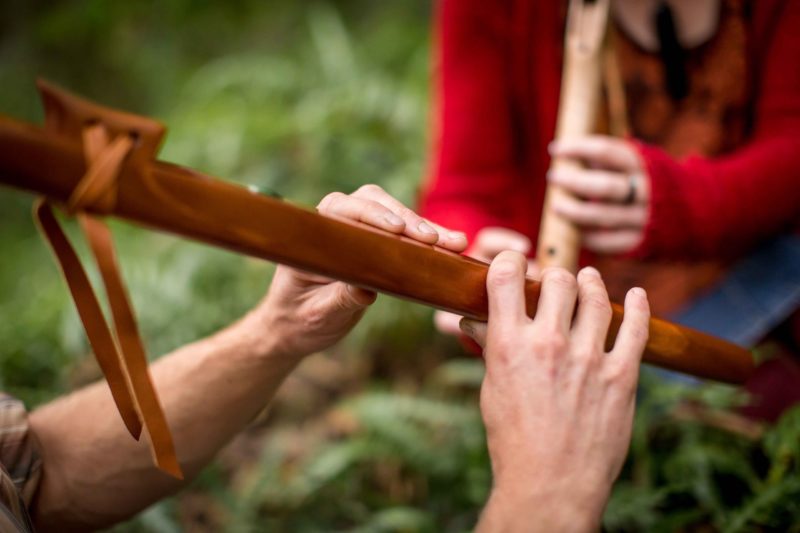
A lot of brilliant musicians would say five, six, seven, or eight. Some of the more advanced players, with knowledge of various musical scales, might say between twelve and fifteen. But if you really deepen your understanding of sound, and what is possible on an instrument like this, you will realize that all of these answers fall well short.
Let’s try another question, far away from the world of flute music.
How may stops are there between Texas and Washington, D.C.?
Some people might answer this by counting the amount of traffic lights along the way. Others might add in pedestrian crossings. Others, more ingenious, might factor in things such as how often the average person needs to stop to use a restroom or eat food.
The truth, of course, is that you can stop whenever it pleases your spirit to do so. It is the same with music.
INFINITY
An ancient sacred text of China, known as the Daodejing (aka Tao Te Ching), declares:
“Naming things loses what unites them. Failing to name things loses them into what unites them.”
Throughout most musical cultures in the world, a recognition of several distinct notes has become embedded in the collective psyche, based (originally) upon simple low-prime ratios that somehow tickle the human brain. Thousands of instruments have been devised that can play these notes – and only these notes. Just as the squares of hop-scotch help small children to effortlessly learn where to place their feet, these notes help newcomers to the world of sound magic jump straight into their musical culture.
Some instruments, like the violin, enable musicians to easily step outside these predefined bounds. Others, like the piano and acoustic guitar, do not. The flute, at first glance, seems to fall into this latter category – the notes are created by placing and lifting the fingers on and off holes, which are expertly positioned to create predetermined notes.
But looks can be deceiving!
Thankfully for us, with the right touch, it is possible to play any note at any point on the spectrum of the Native American Style Flute (which generally spans what we call an Octave plus a Minor Third). This is achieved by carefully sliding the fingers upwards and downwards. There are many words for the effects created by this movement – meend, glissando, portamento. You can also achieve a beautiful (or dramatic) vibrato by gently (or wildly!) wobbling your finger over the hole – try it! You might find that the effect can be less drastic, and easier to control, when you do it a hole or two below the open hole. Or you might have very intelligent fingers that can make small movements more easily than mine 🙂
Here’s a little demonstration of a few vibrato techniques.
There are plenty more, and also plenty gradations of interwoven subtleties when you start varying your breath pressure along with the finger vibrato. (Want a Master technique to aim for? Try a smooth finger vibrato in time with your diaphragm breathing vibrato! I’m not quite there yet myself – I’ve managed it for brief stretches, long enough to glimpse that it’s possible to synchronise these oscillations if we go deep enough.)
With practice, you will find that you can play a continuous glide from the root note to the octave above, with a seamless move of the fingers of both hands. This will prove a challenge at first, but practicing this – even failing at it – will help your fingers become more intelligent, and in time you’ll find that they naturally work better together.
There are many ways to explore the possibilities here. You can think of a specific note that you want to find in-between the holes, and slide your finger until you find it. Or you can simply explore – if you are diligent and pay attention, or are playful like a child, you are guaranteed to find new musical possibilities. Finding them again is the tricky part.
Here’s an idea to inspire you: In the dominant Western system of music, there are 12 notes in the space of an octave. Of course, this is not the whole story. Want to guess how many notes there are in Turkish music within the same space? Fifty-three. Yup. Over four times as many. And even those notes don’t exhaust the possibilities – they are literally infinite.
Don’t let that big number intimidate you – the Turkish masters can play all those notes on the ney, a flute with only six holes!
With a shift of perspective, you can enter an intuitive realm, where you discover notes perhaps unheard before, unnamed. You might find yourself playing phrases featuring more notes than you can count. For myself, I find that the best musical sessions feature a blend of what I can intellectually comprehend, plus leaps beyond – into the unnameable, the unsayable, the untraceable. It’s all about how deep you can go with an open mind.
As the great poet William Blake wrote:
To see a World in a Grain of Sand
And a Heaven in a Wild Flower,
Hold Infinity in the palm of your hand
And Eternity in an hour.
~~
In addition to all these notes, there are overtones – notes on higher registers, that can shine through with certain magic finger positions. Beginners often find these sounds by accident – as you advance, you will gain a feel for how they work, and you’ll be able to add them into your pallet. We’ll have more articles on this in the future.
Here are a few of my explorations. Hope you find something inspiring here 🙂
As you explore the space you will also discover that there are many finger/breath combinations to play the very same note! We’ll discuss this more in a future article. Stay tuned!


No comment yet, add your voice below!